Museums and Exhibitions in New York City and Vicinity
| Home | | Museum Guide | | International | | Architecture & Design | | Theater |
GLENN LONEY'S MUSEUM NOTES
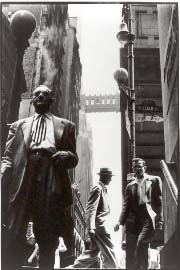 |
| LEONARD FREED'S NEW YORK--See: Vintage Manhattan Photography at Jewish Museum. |
May 31, 2002
NOTED
CURRENTLY
[01] Midtown MoMA Closing!
[02] MoMA Moving to Queens Swingline Factory
[03] Russian Avant-Garde Books at MoMA
[04] Super-Long Exposures for New MoMA Construction
[05] MoMA Sculptures in Bronx Garden
[06] Celebrating Plant Science at the NY Botanical Garden
[07] Rare Books & Illustrations of Plants on View
[08] Workers of the World at St. Etienne
[09] Adrian's High Fashions at the Met
[10] STAR WARS at the Brooklyn Museum
[11] Jewish Life in Ancient Egypt at BMA
[12] Greuze the Draftsman at Frick
[13] Frick's 18th Century Mechanical Table
[14] Vintage New York Photography at Jewish Museum
[15] "American Radiance" at Folk Art Museum
[16] Henry Dargers Obsessive Fantasies
You can use your browser's "find" function to skip to articles
on any of these topics instead of scrolling down. Click the "FIND" button or
drop down the "EDIT" menu and choose "FIND." Copyright © 2002 Glenn
Loney.
For editorial and commercial uses of the Glenn Loney INFOTOGRAPHY/ArtsArchive of international photo-images, contact THE EVERETT COLLECTION, 104 West 27th Street, NYC 10010. Phone: 212-255-8610/FAX: 212-255-8612.
CLOSING! CLOSING! CLOSING! CLOSING!
MIDTOWN MANHATTAN
MUSEUM of MODERN ART
MOVES TO MoMA QNS
[Closed May 21, 2002]
On May 21, the Museum of Modern Art closed its West 53rd Street recycled-Bauhaus building. Although MoMA had been expanded fairly recently—with an income-generating residential tower included—this proved insufficient for the volumes of new & cutting-edge Modern Art which people insisted on creating, even without being urged or commissioned to do so.
Part of the problem was immediately apparent once the new and spaciously wide-walled galleries were opened. Artists such as Frank Stella usurped entire walls with epic expanses of single-minded conceptions, preventing use of such exhibition-spaces by smaller—and possibly more interesting—works of the often derivative Modern Imagination.
Work has already been in progress on a much larger, Japanese-designed MoMA on West 53rd. But this will not be ready for viewing until 2005 AD.
In mid-June, new MoMA exhibitions and treasures from the Permanent Collection will be on display in a remodeled factory in Queens/Long Island City. Below—recycled from a 2001 Curator's Choice report—is the relevant information about the new venue:
MoMA TO RULE IN QUEENS!
Old Swingline Staple Factory
Undergoes Post-Modernist Transformation
[Opened June 2002]
MoMA—as you may have known it on West 53rd Street—is now undergoing a transformation and enlargement. This required that the Museum of Modern Art had to close May 21, 2002.
The Alberto Giacometti exhibition continued until that time. The controversial retrospective of the German artist, Gerhard Richter, remained on view until the closure. These—together with an exhibit of Russian Avant-Garde Books—were the last major shows in this historic Bauhaus-inspired venue.
The streetline façade—including the Philip Johnson and Edward Durrell Stone sections—will look largely unchanged when MoMA re-opens on this site in 2005.
The essentially new museum-complex has been designed by Japan's Yoshio Taniguchi. An impressive model of the project and supporting graphics are currently on view at MoMA.
But this doesn't mean that you will not be able to see the Picassos & Matisses for almost three years. Highlights of the Permanent Collection and new exhibitions will be shown in MoMA's handsome new venue, MoMA QNS!
Don't try to scrunch out that last bit as qwnz or quince or knz. A Press Advisory notes that the correct pronunciation will be Mo-Ma Q-N-S.
QUEENS? They've got to be joking, right? That's where all those cemeteries are—on the way to the airports?
No, this is no joke. And MoMA QNS won't become a cemetery for Modern Art either.
MoMA director Glenn D. Lowry and MoMA's board—led by benefactress Agnes Gund—had long realized that the current exhibition, office, and storage areas had to be replaced with larger, more efficient spaces. In fact, Lowry told the press—on a junket to the new Queens venue—that MoMA's vast collections are now scattered about the city in no less than 18 storage locations.
Initially, MoMA was attracted to the Borough of Queens in search of an existing building large enough and structurally sound enough to house and protect its tremendous and—in some cases—priceless holdings.
They found the old Swingline Stapler Factory—with floors-through featuring 20-foot-high ceilings. This recommended itself not only a potential state-of-the-art storage, conservation, research, and teaching center.
But it was immediately apparent that its grand ground-floor could make a spacious venue for ongoing exhibitions while MoMA was in exile from West 53rd.
Los Angeles architect Michael Maltzan—working with MoMA's New York architectural advisors on the building-conversion, Cooper, Robertson—has devised an ingenious series of Post-Modernist ramps to attract art-lovers into the new galleries, library, cafe, and shop.
Close by is The Factory, which will provide additional office-space for MoMA's many activities.
The MoMA website will keep old friends and new posted on projects and progress both in Queens and Manhattan. Search For: www.moma.org/momaqns & www.moma.org/momabuilds
Another MoMA website innovation is special online exhibitions. Drawing on its superlative collections of 20th century German Art, it has launched Artists of Brücke: Themes in German Expressionist Prints.
The move to Queens—and the need for an additional exhibition-presence—has also led to a new, productive co-operation with P.S. 1 Contemporary Art Center. It boasts the largest collection of contemporary art in the United States. But then there's a superfluity of Cont-Art out there, so it's not hard to build up a huge collection. If you have cash and storage-space…
MoMA is of course concerned that its regulars will be able to find their way out to Queens with a minimum of difficulty.
Glenn Lowry told the press that foreign visitors seem to have no difficulty in finding P.S. 1. It's only Native New Yorkers—read Manhattanites—who act as though they needed visas to get to BAM, Staten Island, the Bronx, and Queens.
To make the trip especially easy, MoMA every weekend has been running regular shuttle-buses from West 53rd to a new Arts-Circuit in Queens. This includes P.S. 1, the Isamu Noguchi Garden Museum, the Socrates Sculpture Park, and the American Museum of the Moving Image.
As soon as the new MoMA QNS opens, it will be included. But you can also reach the site right now—if you want to check out the transformation from the outside—by taking the IRT No. 7 line.
You can most easily board at Times Square or Grand Central Station. As soon as the train emerges from the bowels of the East River, it becomes elevated. This offers a spectacular view of Manhattan and of post-industrial Queens. Architectural gems in Long Island City also dot the skyline.
To reach the new site, get off at the 33rd Street Station. This has been handsomely enhanced by stained-glass windows—in chunky, richly colored glass—featuring local symbols and historical references.
The neighborhoods surrounding each of the arts-complexes are rich with ethnic restaurants representing cuisines of the world. Queens is in effect a Little United Nations now. It was initially developed as a refuge for immigrants crammed into Manhattan's Lower East Side and Hell's Kitchen.
When MoMA QNS is ready, in late June 2002, it will welcome visitors Thursdays through Mondays, from 10 am to 5:30 pm. Unlike the West 53rd Street Wednesday closures, it will be closed on Mondays and Tuesdays.
General Admission will be $10. Of course this does not begin to cover the immense costs of maintaining and servicing the vast collections, mounting blockbuster exhibitions, conducting research, providing archival & library study services, etc., etc.
The generosity of corporate sponsors, arts agencies, and private patrons such as Agnes Gund, Ronald Lauder—and others whose names are often in the cultural news—do much to make this possible.
But the current Queens and Manhattan projects are costing immense sums of money. And, as Glenn Lowry told the media, attendance in the wake of the September 11 disaster had fallen off by 40 percent!
Foreign tourists—who always made a bee-line for MoMA—have been temporarily "scared off" from Manhattan. Lowry is encouraged by the increasing numbers of New Yorkers who are now coming back. Or discovering MoMA for the first time!
What is especially encouraging is that MoMA's board has been able to raise some $507 million for the new projects.
This total was reached after the World Trade Center bombings. That is remarkable, for many agencies, corporations, and wealthy citizens have had to retrench drastically in our wounded, worsening economy.
Last Stand at Manhattan MoMA:
The Russian Avant-Garde Book: 1910-1934
[Closed May 21, 2002]If you have already missed your opportunity to study this tremendously striking show of dazzling visuals and zany texts
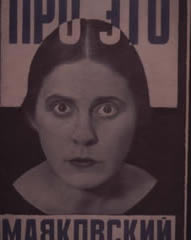 |
| Rodchenko's Avant-Garde Russian Design for Maykovsky Book. Photo: ©MoMA/2002. |
by the time you read this, do not despair!
The 300 books and visuals on exhibition are only a part of MoMA's new holdings of over 1,100 avant-garde illustrated books and over a hundred related works. These will be available in the permanent collections for study and viewing.
There is also a handsome catalogue available, so you can have copies of the most impressive of the books and their illustrations in your own permanent collection. The bulky but artfully-designed volume has some 594 color-illustrations in its more than 300 pages! Its layout is quite as impressive as the art it depicts and describes.
The striking designs created for Pre-and-Post-Revolutionary Russian books—of often surreal poetry and marginal avant-garde fiction—are still being copied or adapted by modern advertising designers.
The Western European influences of Cubism, Futurism, and other new arts movements informed some early Russian experiments in book-design and illustration. But printing small books of poetry on wall-paper had to be a distinctly Russian way of overcoming economic barriers to publication.
There was a popular vaudeville joke in the 1920s which could obliquely describe some of the most powerful of these avant-garde illustrations:
Q: What's black and white and red all over? A: A newspaper!
In fact, using only white paper, black type and design elements, and bold red blocks and lines of color, resourceful and imaginative Russian avant-garde artists served the Revolutionary Movement and its subsequent Soviet with very powerful images with minimal—and low-cost—means!
With the addition of strong black-and-white photographs—singly or in collage—propaganda and "educational" needs of the Soviet were also very well served. Unfortunately, Josef Stalin did not like Modernism of any kind, especially the Constructivism and Suprematism these avant-garde artists were developing.
So the imposition of Soviet Realism in the early 1930s ended most of this adventurous exploration of new visual parameters in book and poster-illustration.
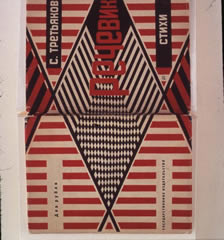 |
| Russian Constructivist Book-Jacket by Aleksandr Rodchenko. Photo: ©MoMA/2002. |
Fortunately, some Russians of real sensibility collected these books and illustrations—some in very limited hand-made editions. The Judith Rothschild Foundation assembled the wide-ranging collection which is now held by MoMA.
Some of the Russian avant-garde artists represented in these books have already become well-known—Post-Berlin Wall Fall—as painters and designers in the West. But this is the first time there has been a definitive exhibition of their ground-breaking contributions to the printed-book.
Among the talents on view, in the catalogue, and in the MoMA Archives: El Lissitzky, Olga Rozanova, Natalia Goncharova, Aleksandr Rodchenko, Kazimir Malevich, Mikhail Larionov, and, yes!, Marc Chagall.
LONG EXPOSURES UNDER WAY TO CAPTURE
THE AMBITIOUS CONSTRUCTION AND
RENOVATION OF THE MUSEUM OF MODERN ART
[Project Completion 2005] German artist/photographer Michael Wesely is recording the transformation of the old MoMA into a new and super-modern art-museum. He has placed cameras on four sites surrounding the former sculpture-garden in the rear of the original museum-building.
They have been there since August 2001, but the color and b&w negatives in the cameras will not be fully exposed until the new museum is completed in 2005. When at last completed, they will document stages in the building's construction, each a translucent layer in a large-scale composite photograph.
Talk about waiting a long time for your prints to come back!
Recording on-going construction on Berlin's Potsdamer Platz, Wesely took 26 months to expose two signature-photographs.
 |
| PABLO PICASSO'S SHE-GOAT--Now in the Conservatory Garden of the New York Botanical Garden. Photo: ©MoMA/2002. |
Sculpture from MoMA
At The New York Botanical Garden
[Closing August 21, 2002] With MoMA's former Sculpture Garden now a bustling building-site, some of its most imposing castings cannot be seen there anymore.
Fortunately, such imposing figures as Rodin's heroic Monument to Balzac have now been installed in the enclosed Gardens of the Enid A. Haupt Conservatory of The New York Botanical Garden.
This remarkable parkland used to be known popularly as the Bronx Botanical Garden—matching the Brooklyn Botanical Garden and the Staten Island Botanical Garden. But the latter two were never a match for the expansive gardens in the Bronx. They are interesting in all seasons, but most colorful in spring and autumn.
The Haupt Conservatory—similar to the Victorian Glass-House in San Francisco's Golden Gate Park—is, however, much larger, being in fact the largest such iron-and-glass construction in the United States.
In MoMA's garden, the sculptures were always backed by apartments across the street or the museum itself. Balzac now stands free against the open sky. Other sculptures also soar skyward, but most hug the ground, with the Victorian conservatory panels behind them.
Picasso's She-Goat now looks much better outside than she did in the MoMA galleries.
Other museum-favorites who have arranged to spend their summer in the Bronx—across the road from Fordham University, in fact—include:
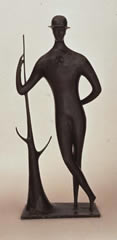 |
| ELI NADELMAN'S MAN IN THE OPEN AIR--Currently in Bronx Open Air! Photo: ©MoMA/2002. |
•Giacometti's Tall Figure III
•Maillol's The River [actually a reclining female nude!]
•Lachaise's Standing Woman
•Henry Moore's two-part Family Group
•Rodin's St. John the Baptist Preaching
•Nadelman's Man in the Open Air [the right place for him at last!]
•Shapiro's Untitled [after all that welding, he still couldn't think of a title?]
•Lipchitz's Figure
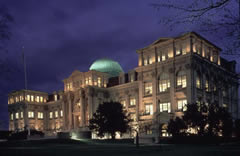 |
| BOTANICAL GARDEN
LIBRARY AT NIGHT. Photo: ©Robert Benson/2002. |
A Garden of Flowers
[Closed June 9, 2002]
In the Haupt Conservatory a woodland spring garden has been recreated. Even if the cherry-blossoms outside in the parklands have scattered in the spring winds, you can enjoy the finest and most colorful of spring blooms and plants inside!
This will be followed in the Conservatory—from June 25 to October 27—with Victorian Ornamentals. This exhibition will recreate the effect of a Victorian garden.
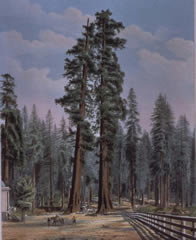 |
| TWO SEQUOIAS--From 1884 reference in NY Botanical Garden Library. |
In Celebration of Plant Science
Those who make the pilgrimage to the Bronx to visit the Botanical Garden and the Haupt Conservatory—which is its unquestionable visual centerpiece—should also allow time to explore the new and restored LuEsther T. Mertz Library and the Steere Herbarium.
At the main entrance—with the Conservatory on a hill to the right—the Library-complex, on a small rise to the left, may look like a late 19th century academic building.
But appearances are deceiving. It has been completely Post-Modernized inside, and the Herbarium on its right-side is definitely State of the Art post-modernist. This is not only a working botanical research-center, but also a venue for exhibitions of the amazing plant collections and reference-books.
The sunny, spacious new library reference, rare-books, and reading rooms are a pleasure to use. The latest of scientific magazines and journals are available, as are some very rare and beautiful botanical books.
Professors and students from New York's major universities are working side-by-side on research projects which extend far beyond the Bronx. How about collecting, classifying, and studying Poisonous Plants in Peru?
The book and journal stacks are also State of the Art. The huge shelves move on trackage which permits thousands more volumes to be preserved in a controlled environment.
Pressed & preserved plant specimens—some of them very old—are available for view and study. Apparently, the cannabis samples disappeared during the Hippie Era…
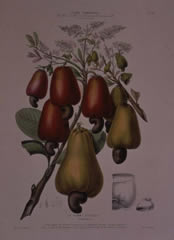 |
| CASHEW FRUITS--Illustration in LuEsther T. Mertz Library in Bronx. |
Plants and Gardens Portrayed:
Rare and Illustrated Books
From the LuEsther T. Mertz Library
[Closed July 31, 2002]
The numerous cultural benefactions of the late LuEsther T. Mertz do not always carry her rather cumbersome name so prominently as the Botanical Garden's Library. But she deserves credit for her vision in endowing this important research resource.
The Mertz Family made their mark—and their money—with Publishers' Clearing House. So it's only appropriate that she endowed a library! Not to overlook her Lincoln Center benefactions…
The library's new gallery is intimate—with low-level lighting to protect the precious manuscripts and illustrations. But the showcases are arranged for maximum circulation of the viewers of these handsome and often very rare volumes and plates.
On view are large-scale drawings of exotic plants—some colored, some in original wood-block or engraving states. But there are also some important examples of books dedicated to formal gardens in various eras. In fact, eight centuries of books on gardens and botanicals are represented in the current exhibition.
Among the rarities: Konrad von Megenberg's Das Puch der Natur. This was published in 1475—before German spelling became stabilized. Today, Puch would be Buch. This volume includes the earliest use of a plant plate as an illustration.
And even more examples are available for study in the neighboring Rare Book Room.
If you think LuEsther T. Mertz is a long honorific for a library, consider the gallery's titular donors: It is The William D. Rondina and Giovanni Foroni LaFaro Gallery!
At the Galerie St. Etienne:
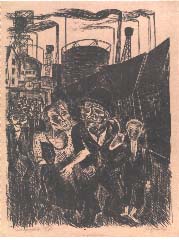 |
| WORKERS OF THE WORLD--Litho of German Coal Miners Coming Home. |
WORKERS OF THE WORLD:
Modern Images of Labor
[Closing June 15, 2002] The Galerie St. Etienne is justly known for its advocacy of German and Austrian artists of the 20th century. Especially the Expressionists and others who reflected social, cultural, and even sexual turmoil from the Jahrhundertwende through two World Wars.
So it is ideally positioned to mount a new show of modern artist depicting workers and labor in this past turbulent century. For that matter, even Grandma Moses—who was hardly a German Expressionist but is a Galerie Special—painted New Englanders at work on farms and in villages!
Among the bold, powerful, often disturbing images now on view are drawings, etchings, watercolors, painting, and lithographs. Some of the images are clearly propaganda posters, but no less striking in their design and imagery.
Galerie favorites such as Käthe Kollwitz, John Heartfield, Max Liebermann, George Grosz, and Sue Coe have pride of place. But Diego Rivera, Honoré Daumier, Camille Pissarro, Gustav Klutsis, and even Jean-François Millet offer a broader range of European and New World visions.
Americans Philip Evergood, William Gropper, Ben Shahn, Jack Levine, Raphael Soyer, and Lester Beall are also represented. The Depression Era Lives Again!
At the Met Museum:
 |
| JOAN CRAWFORD GOWNED BY ADRIAN. |
ADRIAN: American Glamour
[Closing August 18, 2002]This is another one of the Met's always impressive Costume Galas. Usually, the accompanying Opening Party is even more dazzling than the actual costumes.
But Gilbert Adrian's sleekly seductive fashions—made famous worldwide by his designing for Hollywood films—remain classics. Adrian's gowns are never really out of fashion.
And they are so Classically Modern that contemporary clothing-designers are always cribbing from Adrian's silhouettes, lines, drapings, and decorative details.
Here's what the Met has to say about him:
"Gilbert Adrian [1903-1959] was one of the most quintessentially American of 20th-century couturiers, as well as a Hollywood designer of great renown. He dressed Greta Garbo, Norma Shearer, Katharine Hepburn, and Joan Crawford [among others] for the screen.
"No less dramatic were his fashion designs, which united a mid-century modernist sensibility with an extraordinarily engineered technique that continues to inspire designers. This retrospective depicts both aspects of his career."
At the Brooklyn Museum of Art:
 |
| STAR WARS ROBOTIC
STAR. Photo: ©Eric Long & Mark Avino/2002. |
STAR WARS: The Magic of the Myth
[Closing July 7, 2002]This astonishing visual tribute to George Lucas and his co-creators of a Modern Cinema Legend has evolved considerably since I first saw it in San Francisco at the Yerba Buena Center.
At that time, it was dazzling on its own terms. Not only because of the opportunity to see the space-ship models, the robots, the costumes, and the painted backgrounds up close. But also because they were crowded so closely together. It was Visual Overkill!
Lucas—who lives and works just across the SF Bay in Marin County—was giving Bay Area residents, and especially their children, a very special treat.
The show was such a sensation that the Smithsonian Institution picked it up. And it has now been on an extensive tour for some time.
But—just as some New Yorkers have questioned Motorcycles at the Guggenheim and Baseball at the American Museum of Natural History—some Brooklynites were annoyed at what they regarded as Lucas using their pristine BMA for promoting his eminently revivable Star Wars Film Cycle.
 |
| DOUG CHIANG'S STAR WARS PODCRASHER CONCEPT-PAINTING. |
Actually, this handsome show has proved as big an audience-attraction on Eastern Parkway as Baseball has on
Central Park West. Thanks to Lucas' Star Wars™, many parents and children—who would never have visited the BMA otherwise—have now discovered the other riches of this Major American Museum. Not to overlook its gift-shop!
To disarm critics—who have attacked the BMA for its recent controversial exhibitions of new British art and Black Photographers—the museum curators have prefaced the Lucas Artifacts with some of the museum's own treasures which they believe demonstrate the pervasiveness of Myth & Legend from ancient times to the present.
And, indeed, the Smithsonian's reorchestration of the original San Francisco showing uses wall-panels to emphasize the various Elements of Legend embodied in the Star Wars Legend.
There is a handsome exhibition catalogue, written by New York Theatre Historian Mary Henderson. And the gift-shop/bookstore is well stocked with Star Wars Collectibles. Some fans are digging deep into plastic containers of toys and novelties to find their favorite images.
Also at BMA:
Jewish Life in Ancient Egypt
[Closed May 12, 2002]Millennia Ago, having Built the Pyramids—and having Terrorized the Pharaoh and his People with Deadly Jehovah-Mandated Plagues—there was a Mass Emigration of Jews out of Egypt, through the parted Red Sea, and onward toward the Promised Land.
But Jews did not desert the Land of Oppression for All Eternity. Long after the Legendary Exodus—but still in antiquity—there were Jews living in Egypt.
This fascinating insight into the life of an actual Jewish family—from records surviving from the period 449-402 BCE—is an amazing testimony to the cosmopolitan possibilities of Jewish life long before there was a Diaspora.
Enhanced by other ancient artifacts from the BMA's collections, the heart of the exhibition is suite of eight papyri: a family archive, written in Aramaic, of a Jewish temple-official on Elephantine Island in the Nile Valley.
At the Frick Collection:
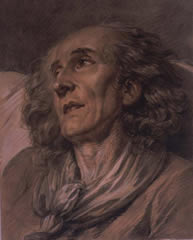 |
| BUST OF AN OLD MAN--J-B Greuze master-drawing at Frick Collection. |
Greuze the Draftsman
[Closing August 4, 2002]Jean-Baptiste Greuze is not exactly a name to conjure with, when commentators are summoning up visions of elegant 18th Century French art, design, and decoration. Fragonard and Boucher are more often evoked.
And yet, Greuze was in his time widely regarded as one of the most sensitive and skilled of French artists. And his drawings and paintings were collected by European aristocrats even as distant as the Imperial Court of Catherine the Great.
Perhaps the major barrier to wider recognition for Greuze today—at least among museum-goers and even art-collectors—was his fondness for depicting detailed genre-scenes of often humble life.
While these are very carefully observed—and his surviving sketch-studies for major canvases have long been eagerly collected—the paintings themselves no longer have the topical interest they must once have had.
Especially among 18th Century French Intellectuals who were sympathetic with the plight of workers and peasants. As long as they did not actually have to meet or live among them…
Today, such major Greuze paintings—salon stars in their day—are mainly interesting to the general viewer as historical records of ordinary life and customs—if they are interesting at all…
But Greuze's remarkable talents as a draftsman—his ability to catch the smallest and most telling detail in a smile or a wave of woman's hair—were unparalleled. Then and now.
And he knew it—which did not endear him to fellow-artists or the Academy.
A famously difficult and contentious man, Greuze was exceeded in these qualities only by his once beautiful wife—who made his life a metaphoric hell.
The drawings on view at the Frick offer ample evidence of this master's talent and of his distinctive choice of subjects.
Also on View at the Frick:
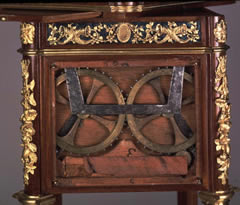 |
| HIDDEN COG-WORKS--Martin Carlin's 18th Century Mechanical Table at the Frick. |
Martin Carlin's Mechanical Table
Henry Clay Frick was able to buy the very best—even the almost priceless—of artworks for his collections at his homes in Pittsburgh and on Manhattan's Fifth Avenue. But, in a sense, he also bought J. P. Morgan's art-treasures second-hand.Both the Fragonard Panels and the handsome 18th century French writing-table in the Frick Collection's Fragonard Room were previously owned by Morgan. The famous art-dealer, Joseph Duveen—who advised both Morgan and Frick on art-purchases—bought this delicate but elaborately decorated table from the Morgan Estate and resold it to Frick.
Ordinarily, museum visitors see only a small 30-inch-high four-legged table in the Fragonard Room. Now its intricate internal mechanism has been set in motion to open it up as a writing desk.
There are also photographs to show its various possible positions and uses, as well as the interior cogs, hidden behind the Sèvres porcelain panels on its four sides.
At the Jewish Museum:
 |
| LEONARD FREED'S NEW YORK, NEW YORK--Vintage Manhattan Photo at Jewish Museum. |
New York: Capital of Photography
[Closing September 2, 2002]Still smarting from all the outrage over its current exhibition of Nazi Imagery—as recycled by young contemporary Jewish artists—as little more than a transformation of once-chilling symbols into Consumerist Logos, curators at the Jewish Museum must be breathing more easily now they have an admirably interesting and safe show on hand.
Most of the photos of New York City now on view are vintage black-and-white. But some recent ones are in not very impressive color. A number of these photos are already well-known from previous photo-shows and books.
But it's always a welcome reunion to encounter once again on a gallery-wall signature-photos of Henri Cartier-Bresson, Berenice Abbott, Diane Arbus, Edward Steichen, Walker Evans, Andreas Feininger, Gjon Mili, Ruth Orkin, Gordon Parks, Ben Shahn, Alfred Stieglitz, Paul Strand, Garry Winogrand, James Van Der Zee, Margaret Bourke-White, Lisette Model, and Weegee!
Several images by Lewis Hine are especially memorable. And, for contemporary balance, there two shots by Nan Goldin. These are, however, quite different sensibilities. If you admire Hine's work, you may be baffled by Goldin's agendas.
To see some of the older pictures of immigrant New York, of bygone Broadway entertainments, of Coney Island crowds—with no room to lie down on the beach—is to take a Time-Journey to a New York City most now living never knew.
At the American Folk Art Museum:
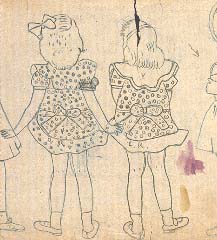 |
| SUGAR AND SPICE--Henry Darger's Vision of Little Girls at American Folk Art Museum. |
American Radiance
[Closed June 2, 2002]Recently opened—only a few yards away from what will be in 2005 the new MoMA—the American Folk Art Museum is itself a major work of modern art & architecture. It should be seen for itself alone. But its contents are also well worth the trip to West 53rd Street.
Designed by Tod Williams and Billie Tsien, the new museum's unusual exterior suggests a work as yet unfinished. Inside, it is a continual surprise from all angles and all levels. It is itself a kind of Internal Structural Sculpture.
It would be something to stare at in astonishment, even if it had no American Folk Art on display. The various ways the architects have used glass, steel, stone, and stairs to relate the necessarily narrow internal spaces to each other is most ingenious and innovative.
A brutal concrete wall featuring naively made American weather-vanes and other images is arresting above and below. But when one is on the level of one of these pieces, the space is too narrow to back-off and get a really panoramic look at it.
As the spaces thus dictate a linear/planar form of exhibition, text-panels, illustrations, photos, and actual artifacts are artfully strung out along the walls or in thin cases mounted on poles, permitting viewer-passage through several lengths of artworks.
One of the its most generous and knowledgeable patrons, Ralph Esmerian—chairman of the Board of Trustees—has donated his remarkable collection of Naive Folk Art to the Museum.
Shown under the title of "American Radiance," this is the first—and supposedly—only time the Esmerian Collection "will be shown in its entirety." Of course, it is easy to say that now, but a decade from now, who knows? It might again make its appearance in its absorbing entirety!
Early American naive portraits are a distinctive feature of Esmerian's wide-ranging arts & crafts objects. He was fortunate to have begun collecting seriously in Pennsylvania-Dutch country.
Before Naive Art was really discovered in a big way. And before New Yorkers really discovered Lancaster and Bird-in-Hand.
Well before Esmerian, however, Henry Chapman Mercer was combing attics and defunct workshops in Pennsylvania to recover the tools, trades, and objects of American Craftsmen and Folk Artists.
His Mercer Museum in Doylestown, PA, is a remarkable repository of such work. And the poured-concrete single-piece museum—built with the aid of his horse, Dolly—is quite as unusual a work of architecture as the new one in Midtown Manhattan.
[My own good fortune as a collector was to have discovered a second-hand bookstore in Lancaster when I first came to New York in 1960. There I bought 18th century Pennsylvania-Dutch Family Bibles, Godey's Ladies' Books, and McGuffy Readers for only a few dollars. Sometimes only a quarter for a 150-year-old schoolbook!]
Also at the Folk Art Museum:
DARGER: The Henry Darger Collection
One of the most fascinating—and obviously obsessive—of American Naive Artists to gain recognition in recent years is Henry Darger. The American Folk Art Museum has major holdings of his works, including his complete writings.These run to over 30,000 pages, some in delicately written copper-plate hand. Others are painstakingly typed on crowded pages. Darger—who lived and created his Imaginary Universe in an attic-room in Chicago—also taught himself to draw so he could illustrate his fantastic narratives with long scrolls of action-scenes.
What curators call his Masterpiece has the total title of: The Story of the Vivian Girls, in what is known as the Realms of the Unreal, of the Glandeco-Angelinnian War Storm, Caused by the Child Slave Rebellion.
In Darger's fantasies, children were usually both the Victims and the Liberators—with Adults as the Abusers, Abductors, or Enslavers.
That this clearly intelligent Loner was emotionally and sexually arrested in his development—at least by Contemporary Chicago Standards—is apparent in his obsessive rendering of naked little girls often with male genitals. He also presents them fully-clothed, in fashions copied from popular magazines.
Cowboys and US Cavalry—as well as adult male villains—also feature in his extended drawings and his even more extensive narratives.
You have to see the texts and the long, long scrolls to witness—if not comprehend—what Darger imagined and then committed to paper.
It is almost unbelievable, incredible. An Analytic Field-Day for psychologists, of course. But you can form your own opinions, after you have seen the Vivian Girls in Action!
From an unknown, Darger has suddenly skyrocketed—in prices, as well—into the Stratosphere of Naive Art Collectibles. The American Folk Art Museum is not the only repository, in fact.
Galerie St. Etienne, among others, features his works. As an American Folk Artist, he's certainly much more interesting than their other favorite, Grandma Moses! [Loney]
Copyright © Glenn Loney 2002. No re-publication or broadcast use without proper credit of authorship. Suggested credit line: "Glenn Loney, Curator's Choice." Reproduction rights please contact: jslaff@nymuseums.com.